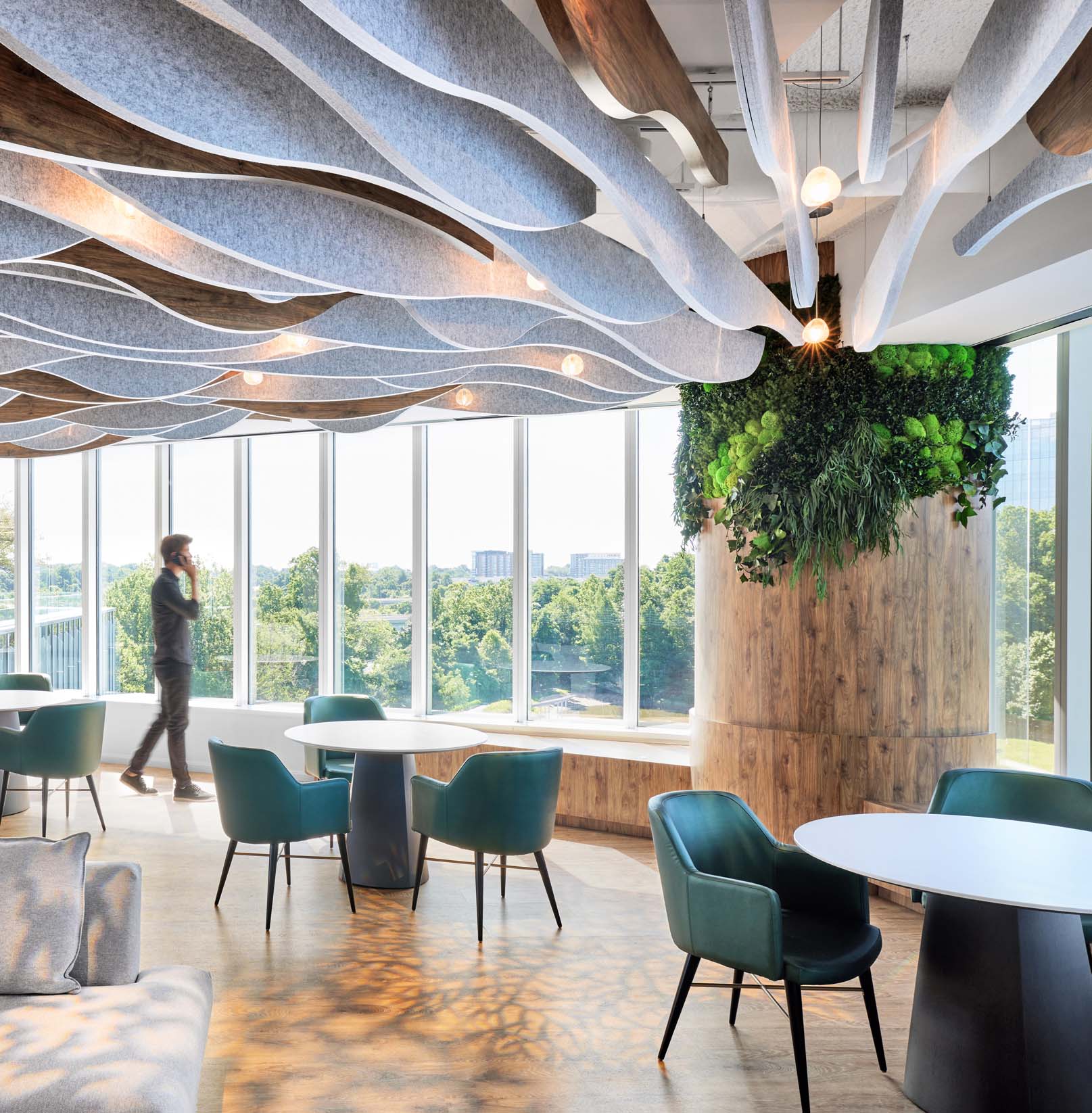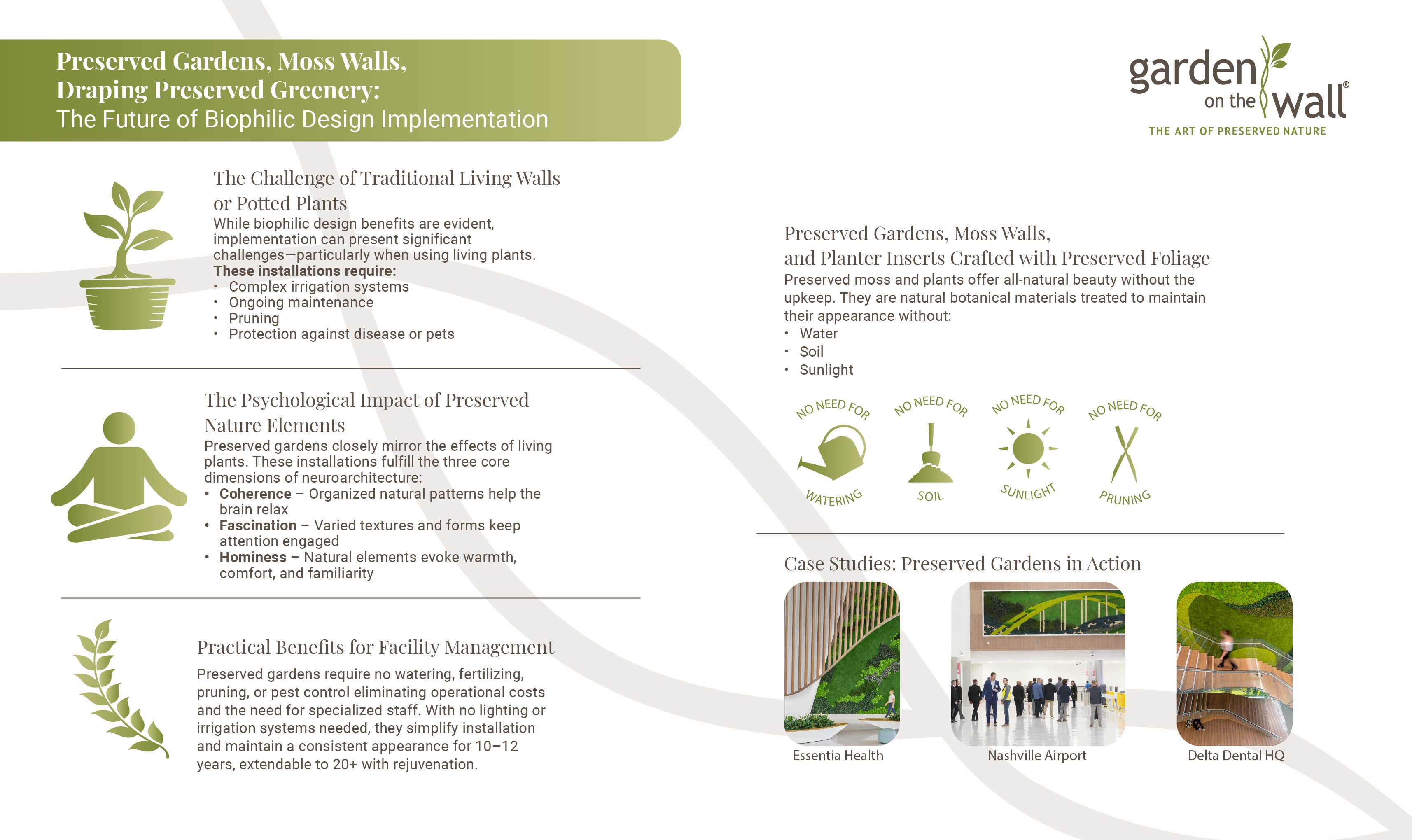Garden on the Wall®
Preserved Gardens, Moss Walls, Draping Preserved Greenery: The Future of Biophilic Design Implementation

As the benefits of biophilic design become increasingly clear, facility managers and designers face a growing challenge: how to implement nature-inspired environments that deliver psychological benefits without the operational headaches of traditional living installations. The answer lies in an innovative solution that’s transforming how we bring nature indoors preserved gardens.
The Challenge of Traditional Living Walls or Potted Plants
While the benefits of biophilic design are evident, implementation can present significant challenges, particularly when using living plants. Traditional "living walls" require complex irrigation systems, ongoing maintenance, pruning, and protection against disease and pests. For many facilities especially high-traffic commercial spaces, healthcare environments, and hospitality venues these maintenance demands can become prohibitive.
Typical living walls incorporate live plants onto a vertical substrate with provisions for watering and fertilizing, keeping them well-lit, and managing disease and insect invasions. They also require constant maintenance to remove dead leaves and replace dying plants. Facility managers must monitor for leaks and water damage to surrounding finishes and structure. Similar concerns arise with potted plants, which often become breeding grounds for gnats, flies, and other insects as the plants propagate naturally.
This level of complexity often puts biophilic design benefits out of reach for many projects, despite the growing body of evidence showing that natural elements in the built environment can boost productivity, improve morale, stimulate cognitive function, lower blood pressure, reduce stress, balance hormone levels, and regulate mood swings.
Preserved Gardens, Moss Walls, and Planter Inserts Crafted with Preserved Foliage: The Optimal Biophilic Solution
Preserved moss and plants are natural botanical materials that have been treated to maintain their appearance and texture without requiring water, soil, or sunlight. Though no longer living, they retain their natural beauty and biological structure for decorative use.
Unlike artificial plants, which fail to trigger the same neurological responses as authentic botanical elements, preserved plants maintain the real organic textures and subtle variations that our brains identify as natural. This authenticity is key—our cognitive systems are remarkably adept at detecting the difference between real and synthetic nature, even on a subconscious level.
Garden on the Wall® (GOTW), a pioneer in preserved garden installations, has led the industry in developing sustainable, maintenance-free biophilic elements. Their preserved gardens and moss walls offer the psychological benefits of connecting with nature without the challenges of living plant maintenance.
According to a recent survey conducted by ThinkLab of Sandow Design, interior designers rank several product attributes as top considerations when specifying materials: durability/life cycle, aesthetics, lead times, cost of ownership, sustainability, and material health. GOTW addresses all these criteria seamlessly.
The company’s installations have transformed interiors across diverse market sectors—from corporate campuses and healthcare facilities to hospitality destinations and transportation hubs. Their preserved gardens last 10–12 years and can be extended to 20+ years with a specialized rejuvenation process, offering exceptional longevity and value.

The Psychological Impact of Preserved Nature Elements
The psychological benefits of preserved gardens closely mirror those of living plants. In built environments, they fulfill all three core dimensions identified in neuroarchitecture research: coherence, fascination, and hominess. These installations provide organized natural beauty (coherence), generate visual interest through varied textures and forms (fascination), and evoke the warmth and familiarity of natural settings (hominess).
Beyond these general benefits, preserved installations offer specific advantages for both neurotypical and neurodivergent individuals. For neurotypical occupants, preserved gardens support psychological, physiological, and hormonal well-being. For neurodivergent individuals, they can mitigate sensory overstimulation and reduce anxiety, helping to calm the nervous system and improve focus.
Case Studies: Preserved Gardens in Action
The transformative impact of preserved gardens is evident in installations across multiple sectors.
At Essentia Health’s St. Mary’s Medical Center in Duluth, Minnesota, a sprawling preserved garden spans three stories 33 feet high and 25 feet wide flowing across curved millwork and walls. Featuring forest plants, ferns, and eucalyptus over a moss canvas, the garden mimics Duluth’s surrounding hillside views. This installation earned the Best of Competition Award from the International Interior Design Association (IIDA) Healthcare Design Awards.
At Nashville International Airport, two massive garden installations stretch 105 feet along each side of the security lanes, making them the largest preserved garden installations in the world. Titled “Taking Flight,” these immersive installations reference local bridges, musical motifs, and abstract representations of the Nashville landscape. The gardens not only enhance aesthetics but also help reduce the stress associated with airport security checkpoints.
In another creative application, an award-winning project for Delta Dental featured a preserved garden designed in the shape of a tooth—symbolizing the company’s core mission. Designed by Huntsman Architectural Group, the garden spans three stories along a central staircase, creating a biophilic vista that connects floors and fosters a sense of cohesion throughout the space.
Practical Benefits for Facility Management
From a facility management perspective, preserved gardens offer clear advantages:
- Maintenance-Free Operation: No watering, fertilizing, pruning, or pest control required eliminating ongoing operational costs and the need for specialized horticultural staff.
- Longevity: Preserved gardens maintain their visual appeal for 10–12 years and can be rejuvenated to extend life to 20+ years.
- No Infrastructure Requirements: Unlike living walls, preserved installations don’t require irrigation systems, drainage, or special lighting simplifying installation and reducing risk.
- Consistent Appearance: Preserved elements retain their appearance regardless of seasonal changes, lighting, or building systems.
- Health and Safety: With no soil, water, or living organisms, preserved gardens avoid mold, bacteria, and allergen concerns often associated with living plant systems.
Environmental Sustainability
Preserved gardens also support environmental goals by eliminating the need for water, fertilizers, and pesticides, reducing resource consumption. Their longevity reduces the need for replacements, lowering material waste. In addition, many of the plants used in these installations are sustainably harvested.
Compared to live walls or synthetic greenery, preserved gardens offer a low-impact, high-performance option that blends beauty, longevity, and responsibility.
The Future of Biophilic Implementation
As biophilic design continues to evolve, preserved gardens are emerging as a powerful, practical way to bring nature indoors. They fulfill our innate desire for connection to nature without the burden of complex maintenance or infrastructure.
These all-natural gardens are being increasingly specified across healthcare, corporate, hospitality, retail, education, and transportation sectors. Whether used to reduce stress in medical settings, enhance productivity in offices, or create memorable guest experiences in hospitality spaces, preserved gardens deliver the benefits of biophilia with ease and elegance.
In today’s movement toward human-centered and sustainable spaces, preserved gardens stand out as an accessible, effective solution. They bring the restorative power of nature indoors without compromise.
Related Posts

The Future of Workplaces: Green Office Design Trends to Watch

What to Know About Moss Walls and Preserved Gardens


